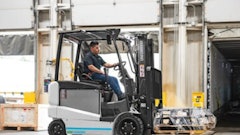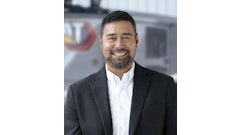
The John Deere 644K Hybrid wheel loader features the latest variation of hybrid technology for construction applications. A diesel engine running at steady state turns an electric generator.
“This machine, compared to our conventional drive 644, uses a smaller engine (6.8-liter),” says John Chesterman, product marketing manager for wheel loaders at John Deere. “It is 229 hp vs. 232 hp. We run at a constant engine speed of 1,800 rpm, whereas a traditional wheel loader will run at 2,250 or 2,350 rpm. We are running at a more efficient point in the engine efficiency curve.”
This provides several advantages. “First off, the engine is always spooled up,” he explains. “We don’t have to worry about response. We have all drivetrain power available.” The engine also runs the hydraulic pump at constant speed so all hydraulic flow and power is available at any time. “That is an advantage over a conventional drive machine.”
“Engines that run generators at constant engine speeds have much longer lives than engines that are constantly hunting up and down the rpm range to make power,” says Chesterman. Also, by turning at a lower rpm, the noise generated is reduced. “The noise level of this machine is 68 dB as experienced by the operator, a full 2 dB lower than our conventional machine. In the world of sound, a 3-dB reduction equates to cutting sound power 50%.”
A Transfer of Energy
John Deere power electronics are the brains of the system. Three cables connect the power electronics to the electric motor. “All of the power to turn the tires is going through those three cables,” says Chesterman.
The electric motor drives a simplified three-speed transmission, but the system has four operating speed ranges in forward and reverse. The transmission on the conventional 644 has four or five forward speeds with three reverse. Reverse gears are not needed on the hybrid. “The electric motor operates equally well [in] forward and reverse,” notes Chesterman. With the conventional 644 you have to shift gears to change directions. “We have eliminated that shifting [by] simply reversing the motor. It is very smooth and very powerful.”
The electric system also recaptures some of the energy that would normally be wasted. “If you let off the accelerator and the machine is slowing, that is actually backdriving the motor,” says Chesterman. “When we backdrive the motor, it acts like a generator. That power then lightens the load on the engine and reduces fuel consumption.
“This is common in a tight V-pattern operation,” he continues. “During a V-pattern operation, the operator is decelerating and reversing while at the same time raising the boom. In a conventional machine, the deceleration energy would be dissipated as braking heat, but in the case of the 644K Hybrid, it is used to assist the engine in providing power to the hydraulic system.”
But this hybrid does not use an energy storage device. “Any excess electrical energy goes to the brake resistor,” Chesterman explains. “The brake resistor allows us to dissipate excess energy to prevent engine overspeed."
Ramping Up Performance
The average customer can expect about a 25% reduction in fuel consumption using the 644K. “That is a mix of various activities — transport, stockpiling, as well as V-pattern truck loading,” says Chesterman. “But if they focus just on V-pattern loading, they will exceed that fuel consumption reduction. From an application standpoint, this machine is not designed to do anything differently than the typical 644.”
The 644K Hybrid is also designed to be easier to use. “Operating a conventional machine can be a challenge because to effectively load the bucket, the operator has to actively manage engine speed, which changes pushing force and hydraulic speed,” says Chesterman. Since the engine on the 644K Hybrid runs at a constant speed, the operator always has full driveline and hydraulic power. “That really helps the novice operators be productive since they can very easily push the bucket into the pile, and they have the hydraulic power to curl the bucket and very quickly maneuver.”
The hybrid technology also allows adaptation of a few unique features, one of which is coast control. With a torque converter machine when you let off the throttle, the loader free-wheels. With a hydrostatic machine, when you let off the throttle, you get dynamic braking. With coast control, you can select from four settings – from no dynamic braking to dynamic braking similar to a hydrostatic machine.
Another unique feature is Full Rim Pull Control. John Deere wheel loaders currently come with Spin Control. “It is a reactive system,” says Chesterman. “It has four different settings.” When a conventional wheel loader starts digging, it drops engine rpm to keep the wheels from spinning. For the 644K Hybrid, the system has been expanded to Full Rim Pull Control. "We are not changing the speed of the engine. It is just not going to generate as much pushing force or rim pull in certain settings."
Similar but Different
The 644K Hybrid uses many of the components of the conventional 644. For instance, the frame is basically the same.
“The axles and brakes are identical to the conventional drive machine,” says Chesterman. “We do some things to the counter-weighting of the machine, but this particular model we manufacture in Stage II emissions, Tier 3 emissions, Interim Tier 4 conventional and now Interim Tier 4 hybrid. We always have to do some juggling based on the engine and the aftertreatment device.”
John Deere teamed up with industry leading suppliers for the electric motors and drives, but it manufacturers its own inverters, as well as the transmission to which the electric motor is attached.
Will this technology be applied to other loaders in the John Deere wheel loader line? Chesterman indicates that this technology is scalable. “We are going to apply the correct technology to the right machine. This technology is flexible.”




















